Clever 4Ever
Le jeu

You try to achieve as many points as possible by skillful use of the cubes in the five color areas. In this case, the cubes should be selected in a clever manner in order to still have sufficient choices for the subsequent litters. Bonus features and promotions offer you various ways to improve your result through skillful use.
Déroulement du jeu
The game runs over 6 laps with two players, 5 laps to third and 4 laps should be played to fourth. Each round is divided into a main and a passive phase.

Main phase
In each main phase you dice three times and each uses one of the active cubes. Then a further throw is executed with all 6 cubes, of which you can then use one from the 3 cubes with the smallest number of eyes.

You dice at the beginning of a round with all 6 cubes and look for a cube you use. Depending on the color of the cube, you must now select a valid field in the matching color from the still available fields in this color. The white cube is a color joker and can be used for any color.
All cubes that show a lower value than the currently selected cube are placed on the silver tray and can no longer be diceed and used again.
With the remaining cubes, you now dice for a second time. You select a cube again, and all the cubes that show a lower value than the currently taken are placed on the silver tray again. Then you dice the other dice for a third time and execute the actions described above for a last time. Then all remaining cubes are placed on the silver tray.
Passive phase

If you have inserted 3 cubes or can no longer cube because all the remaining cubes are on the silver tray, the second phase of a round follows.
All the cubes are diceed again and the 3 cubes are placed with the lowest value on the silver tray. If there is a balance, it will be decided by chance.
From these 3 cubes you can select and enter a cube. After that you can also use the +1 actions here.
Special case: If you have no possibility to use a dice from the silver platter, you can use any dice.
If you can't use a cube from the litter, you've had bad luck.
The 5 colors

For each of the 5 colors, other rules apply for entry and points. You always only use the cube of the corresponding color (or the white joker) to enter something into the area.
Yellow
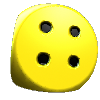
If you choose the yellow cube, you can choose freely in which of the 3 lines you want to enter the cube value.
You start to the left in each line and enter the value into the next free field. So you can't skip a field.
You can choose from any yellow cube in which line you enter.
In the top line you can start with any number. In the following fields, however, you must always enter a number that is higher than in the previous field.
In the two lower rows you can enter any number in each field.
Bleu
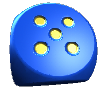
If you choose the blue cube, you have to cross exactly 1 field in this area.
As usual, if you choose the blue cube, you also use the white cube (no matter where it lies).
The two cubes define the field for ticking. The blue cube determines the line and the white cube the column. You cross the field at the intersection.
Grey
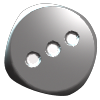
The grey area is divided into different sections. Each group of coherent fields in the same colour (white, light grey, dark grey) is such a subarea.
If you choose the gray cube, you must cross all fields in a subarea.
The number of cubes must be at least as high as the number of fields in the partial area.
You start to the left with one of the two red-edged subareas. All other crosses must be placed horizontally or vertically adjacent to an existing cross.
Green
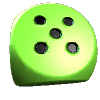
In the green area you can enter up to 2 numbers in each field. The fields are divided into 2 triangles by a green line.
If you choose the green cube, you must first decide whether to enter the cube value into the upper or the lower triangle. When entering, you fill each of the two “line” from left to right.
Pink
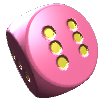
In the pink area, you enter numbers in the fields. You always start to the left and enter a number into the next free field of the bar. So you can't skip fields here.
Depending on the number you enter, the following happens:
Actions

After each throw of the main phase, you can re-scramble the cubes that have just been thrown by means of the "scramble action".

If you use a cube from the silver platter, you may increase or lower the number of this cube by 1. You can also use this action several times to change the number by more than 1. 1 and 6 are not considered to be adjacent.

In addition, you have the possibility to use the "additional cube" action both before the main phase is finished and before the passive phase of each round is terminated. This allows you to use another cube, it can come from both the silver tray and the area of the already used. However, each cube can only be selected once as an additional cube.
Bonuses and points
Some fields (or rows and columns) have a bonus. This is obtained when you mark the field (or when all fields of a row/column are marked). In addition, you will receive a bonus if you have collected all 6 of the 3 different promotions (scatter, number-joker and additional cubes). The bonus allows an entry in the corresponding color, or it grants a "dropper, number joker or additional cube action". The colour bonuses must always be used immediately. If you catch a fox, it will bring additional points in the final settlement.
?

If you catch a ?-bonus, you must immediately cross a field in the color range corresponding to the bonus.
Popular ?

At the bonus at the beginning of round 4, you can freely choose in which color you use a bonus according to the above rules.
Fox

For foxes, you get extra points at the playing end. You can play like bonuses by filling the corresponding field or closing a corresponding column.
Each fox brings as many points as the color range with the least overall points.
Point score
The score of the individual color ranges is as follows:
Yellow
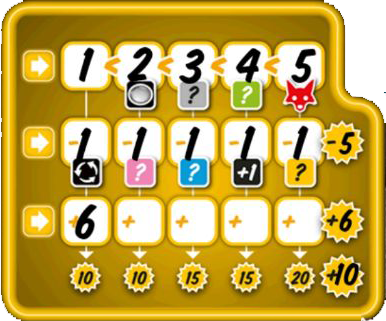
All entered numbers, in the middle line are added together and displayed in the field right next to the line. You get this sum as minus points.
In the bottom line, all entered numbers are also added and entered in the field next to the line. You get these points as positive points.
There are no points in the top line.
Lastly, you get points for each completely filled column. The points specified under the column are added together and the sum is entered in the field next to the line.
Bleu
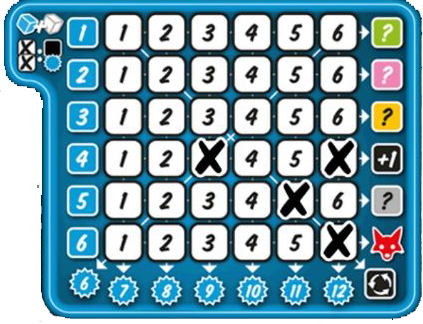
For each column where at least 2 fields are crossed, you will get the points below this column.
You also get points when at least 2 fields in the diagonal are crossed from top right to bottom left.
Grey

For any column that is completely crossed, you get the points that are specified above this column.
Green

When playing, all points are added, which were entered in the points.
The point value consists of the sum of the two triangles of a field. This value is obtained only when numbers are entered in both triangles.
Pink

The last entered field is relevant for gamers. You get the points specified above this field.
In addition, you get points for registered 2s, 4s and 6s (see also overview bar below the number fields).
Fin de la partie
The game ends after you have taken the cube from the silver platter in your passive train in the last round and have used any +1 actions.
The scored points of all color ranges are added together with the points for the foxes.

Let's go! From now on, it's called CLEVER 4 EVER.

